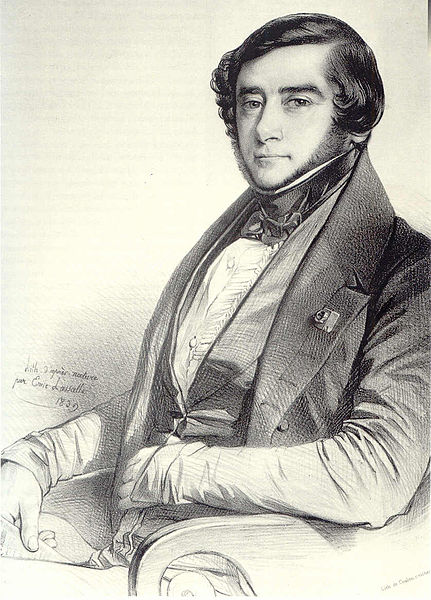<Back to Index>
- Naturalist Alcide Charles Victor Marie Dessalines d'Orbigny, 1802
- Composer Juan Bautista José Cabanilles, 1644
- Président du Conseil des Ministres Guillaume Dubois, 1656
PAGE SPONSOR

Alcide Charles Victor Marie Dessalines d'Orbigny (September 6, 1802 - June 30, 1857) was a French naturalist who made major contributions in many areas, including zoology (including malacology), palaeontology, geology, archaeology and anthropology.
D'Orbigny was born in Couëron (Loire - Atlantique), the son of a ship's physician and amateur naturalist. The family moved to La Rochelle in 1820, where his interest in natural history was developed while studying the marine fauna and especially the microscopic creatures that he named "foraminiferans".
In Paris he became a disciple of the geologist Pierre Louis Antoine Cordier (1777 - 1861) and Georges Cuvier. All his life, he would follow the theory of Cuvier and stay opposed to Lamarckism.
D'Orbigny travelled on a mission for the Paris Museum, in South America between 1826 and 1833. He visited Brazil, Argentina, Paraguay, Chile, Bolivia and Peru and returned to France with an enormous collection of more than 10,000 natural history specimens. He described part of his findings in La Relation du Voyage dans l'Amérique Méridionale pendant les annés 1826 à 1833 (Paris, 1824 - 47, in 90 fascicles). His contemporary, Charles Darwin called this book "one of the great monuments of science in the 19th century". The other specimens were described by zoologists at the museum. He had numerous interactions with Darwin, and named certain species after Darwin; for example d'Orbigny assigned the common name Darwin's rhea to the South American bird Rhea pennata.
In 1840, d'Orbigny started the methodical description of French fossils and published La Paléontologie Française (8 vols). In 1849 he published a closely related Prodrome de Paléontologie Stratigraphique, intended as a "Preface to Stratigraphic Palaeontology", in which he described almost 18,000 species, and with biostratigraphical comparisons erected geological stages, the definitions of which rest on their stratotypes.
In 1853 he became professor of palaeontology at the Paris Muséum National d'Histoire Naturelle, publishing his Cours élémentaire that related paleontology to zoology, as a science independent of the uses made of it in stratigraphy. The chair of paleontology was created especially in his honor. The d’Orbigny collection is housed in the Salle d'Orbigny and is often visited by experts.
He described as first the geological timescales and defined numerous geological strata, still used today as chronostratigraphic reference such as Toarcian, Callovian, Oxfordian, Kimmeridgian, Aptian, Albian and Cenomanian. He died in the small town of Pierrefitte - sur - Seine, near Paris. The following zoological taxa, genera and species, were named in his honor: Nerocila orbignyi (Guérin, 1832), Alcidia Bourguignat, 1889, Ampullaria dorbignyana Philippi, 1851, Pinna dorbignyi Hanley, 1858, Haminoea orbignyana A. de Férussac, 1822, Pink Cuttlefish, Sepia orbignyana Férussac, 1826, Orbignya speciosa (Mart. ex Spreng.) Barb.Rodr. - Brazilian Palmtree "Babaçu", Potamotrygon orbignyi (Castelnau, 1855).